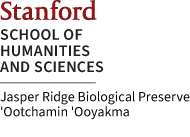Muwekma youth campout, how it came about and why

At Jasper Ridge Biological Preserve ('Ootchamin 'Ooyakma), we have been continuing our efforts to turn the preserve into a place where not just Western science, but both Western and Indigenous science can flourish, and inform each other. Given this new focus, we were honored to learn that Charlene Nijmeh, the Chairwoman of the Muwekma Ohlone Tribe of the San Francisco Bay Area, would like to collaborate with us at JRBP('O'O) on an experience for their youth to camp together. This suggestion was made to the JRBP('O'O) staff during her participation in the pile burn at the preserve in March 2024. Since then, we worked closely with her and other tribal members to plan and hold a youth campout in July 2024.
After much prep work by many people involved, it was rewarding to see everyone enjoying the campout, and to receive favorable post-event survey responses from tribal members as well as positive feedback from Stanford student volunteers. The accompanying post details the activities during the two-day event. Here we reflect on what this event meant to the tribe and the Stanford community.
To the tribe, it was an opportunity for youth members to spend more time on their ancestral homeland and come in contact with the native fauna and flora. Although brief, the campout made room for the sort of childhood experiences that can have a lasting impact on their sense of environmental connectedness to the local land. Moreover, the campout provided a chance for tribal members to come together to catch up with one another and to have a space to offer blessings and dance together.
Unfortunately, the tribe currently has no land base on their own homeland due to the unjust history that has resulted in the loss of federal recognition, which they have been working hard to regain for a long time, most recently through the Trail of Truth protest. Meanwhile, as the Ohlone land becomes increasingly gentrified in the Bay Area, tribal members have been forced to move further and further away from their homeland. Some members who participated in the campout came from their residence more than two hours' drive to JRBP('O'O) even when there is little traffic. In this context, we believe that having tribal members gather at 'Ootchamin 'Ooyakma for a campout and supporting their cultural practices for the tribe’s future generations is one of the most significant things that JRBP('O'O) can do for the tribe.
The campout was not just for the benefit of the tribe, however. To Stanford students, faculty, and staff, it served as an important step toward genuine “two-eyed seeing,” the multi-cultural approach to understanding and solving environmental issues through the use of both Western and Indigenous science. Increasingly recognized as essential to ensuring environmental sustainability, two-eyed seeing is a new goal that JRBP('O'O) has set out to promote in the research, education, and land stewardship efforts conducted at the preserve.
This goal can be achieved only when we work with local Indigenous entities with utmost respect and with deep appreciation of the ecological knowledge and wisdom that their ancestors developed here over thousands of years. Events like this campout allow the Stanford community to cultivate a trusting relationship with people Indigenous to the land that the university sits on. The campout created an informal setting where we got to know one another on a more personal level than otherwise possible. Through this interaction, we can hope to better understand the tribe's needs, priorities, and interests, and work with them toward authentic two-eyed seeing.
For example, on a hike during the campout, Chairwoman Njimeh shared with JRBP('O'O) staff her trip to Hawaiʻi, facilitated by Mike Wilcox, to learn about Leon Noʻeau Peralto’s (’10, B.A. Anthropology and Native American Studies) efforts for place-based stewardship and community education. Inspired by this story, we talked about the future of sustainable land care in the Bay Area, where the main focus can be the reciprocal relationship between the land and the people, as opposed to the dominant notion of setting aside and keeping natural areas as intact and human-free as possible for conservation. The Chairwoman’s vision resonated with us as we thought more about the role that JRBP('O'O) can play in the age of climate crisis. Conversations about shared interests like this help us build a solid basis for future collaboration that benefits both Stanford and our Indigenous partners.
By Tadashi Fukami
Top of page: Muweuka youth member Aria Cazares looking at a Swainson’s thrush as PhD student Julian Tattoni shows how to band a bird. Photo by Marina Luccioni.



